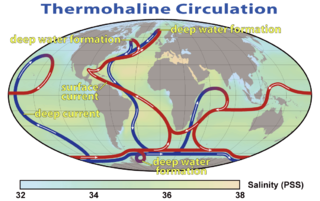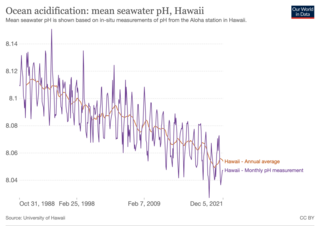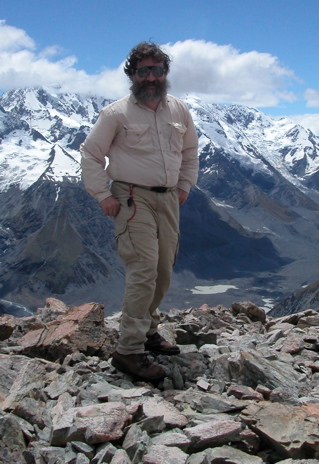Related Research Articles

Oceanography, also known as oceanology, sea science, ocean science, and marine science, is the scientific study of the ocean, including its physics, chemistry, biology, and geology.
Climate engineering is the intentional large-scale alteration of the planetary environment to counteract anthropogenic climate change. The term has been used as an umbrella term for both carbon dioxide removal and solar radiation modification when applied at a planetary scale. However, these two processes have very different characteristics, and are now often discussed separately. Carbon dioxide removal techniques remove carbon dioxide from the atmosphere, and are part of climate change mitigation. Solar radiation modification is the reflection of some sunlight back to space to cool the earth. Some publications include passive radiative cooling as a climate engineering technology. The media tends to also use climate engineering for other technologies such as glacier stabilization, ocean liming, and iron fertilization of oceans. The latter would modify carbon sequestration processes that take place in oceans.

The National Oceanography Centre Southampton (NOCS) is a centre for research, teaching, and technology development in Ocean and Earth science. NOCS was created in 1995, jointly between the University of Southampton and the UK Natural Environment Research Council and is located within the port of Southampton at a purpose-built dockside campus with modern facilities. In 2010 the university and NERC components demerged, and the NERC-managed component became the National Oceanography Centre. The two components of NOCS continue close collaboration through the jointly run Graduate School, shared research facilities and laboratories, complementary research groups, and many joint research grants and publications. The university component “Ocean and Earth Science, National Oceanography Centre Southampton” (OES) is part of the Faculty of Environmental and Life Sciences, (FELS). It was ranked 46th in the world for Earth and Marine Sciences by the QS World University Rankings in 2019.

The Lamont-Doherty Earth Observatory (LDEO) is a research institution specializing in the Earth science and climate change. Though part of Columbia University, it is located on a separate closed campus in Palisades, New York.

Ocean acidification is the ongoing decrease in the pH of the Earth's ocean. Between 1950 and 2020, the average pH of the ocean surface fell from approximately 8.15 to 8.05. Carbon dioxide emissions from human activities are the primary cause of ocean acidification, with atmospheric carbon dioxide levels exceeding 422 ppm. CO2 from the atmosphere is absorbed by the oceans. This chemical reaction produces carbonic acid which dissociates into a bicarbonate ion and a hydrogen ion. The presence of free hydrogen ions lowers the pH of the ocean, increasing acidity. Marine calcifying organisms, such as mollusks and corals, are especially vulnerable because they rely on calcium carbonate to build shells and skeletons.

Raymond Thomas Pierrehumbert is the Halley Professor of Physics at the University of Oxford. Previously, he was Louis Block Professor in Geophysical Sciences at the University of Chicago. He was a lead author on the Third Assessment Report of the IPCC and a co-author of the National Research Council report on abrupt climate change.

Marine ecosystems are the largest of Earth's aquatic ecosystems and exist in waters that have a high salt content. These systems contrast with freshwater ecosystems, which have a lower salt content. Marine waters cover more than 70% of the surface of the Earth and account for more than 97% of Earth's water supply and 90% of habitable space on Earth. Seawater has an average salinity of 35 parts per thousand of water. Actual salinity varies among different marine ecosystems. Marine ecosystems can be divided into many zones depending upon water depth and shoreline features. The oceanic zone is the vast open part of the ocean where animals such as whales, sharks, and tuna live. The benthic zone consists of substrates below water where many invertebrates live. The intertidal zone is the area between high and low tides. Other near-shore (neritic) zones can include mudflats, seagrass meadows, mangroves, rocky intertidal systems, salt marshes, coral reefs, lagoons. In the deep water, hydrothermal vents may occur where chemosynthetic sulfur bacteria form the base of the food web.
Kenneth Caldeira is an American atmospheric scientist. His areas of research include ocean acidification, climate effects of trees, intentional climate modification, interactions in the global carbon cycle/climate system, and sustainable energy.

Gideon Mark Henderson FRS is a British geochemist whose research focuses on low-temperature geochemistry, the carbon cycle, the oceans, and on understanding the mechanisms driving climate change.
Marine chemistry, also known as ocean chemistry or chemical oceanography, is the study of the chemical composition and processes of the world’s oceans, including the interactions between seawater, the atmosphere, the seafloor, and marine organisms. This field encompasses a wide range of topics, such as the cycling of elements like carbon, nitrogen, and phosphorus, the behavior of trace metals, and the study of gases and nutrients in marine environments. Marine chemistry plays a crucial role in understanding global biogeochemical cycles, ocean circulation, and the effects of human activities, such as pollution and climate change, on oceanic systems. It is influenced by plate tectonics and seafloor spreading, turbidity, currents, sediments, pH levels, atmospheric constituents, metamorphic activity, and ecology.
The Asilomar International Conference on Climate Intervention Technologies was a conference developed by Margaret Leinen of the Climate Response Fund and chaired by Michael MacCracken of the Climate Institute. The conference took place in March 2010 and the recommendations were published in November 2010. The goal was identify and minimize risks involved with climate engineering, and was based on the 1975 Asilomar Conference on Recombinant DNA which discussed the potential biohazards and regulation of biotechnology. A group of over 150 scientist and engineers gathered together with lawyers, environmentalists and disaster relief workers in an open meeting to avoid accusations of conspiracy during this discussion. The Asilomar Conference focused exclusively on the development of risk reduction guidelines for climate intervention experiments.
Harry Leonard Bryden, FRS is an American physical oceanographer, professor at University of Southampton, and staff at the National Oceanography Centre, Southampton. He is best known for his work in ocean circulation and in the role of the ocean in the Earth's climate.

The oceanic carbon cycle is composed of processes that exchange carbon between various pools within the ocean as well as between the atmosphere, Earth interior, and the seafloor. The carbon cycle is a result of many interacting forces across multiple time and space scales that circulates carbon around the planet, ensuring that carbon is available globally. The Oceanic carbon cycle is a central process to the global carbon cycle and contains both inorganic carbon and organic carbon. Part of the marine carbon cycle transforms carbon between non-living and living matter.

David John Beerling FLSW is the Director of the Leverhulme Centre for Climate change mitigation and Sorby Professor of Natural Sciences in the Department of Animal and Plant Sciences (APS) at the University of Sheffield, UK. He is also Editor-in-Chief of the Royal Society journal Biology Letters.
John David Woods, CBE is a British oceanographer.

CSIRO Oceans and Atmosphere (O&A) (2014–2022) was one of the then 8 Business Units of the Commonwealth Scientific and Industrial Research Organisation (CSIRO), Australia's largest government-supported science research agency. In December 2022 it was merged with CSIRO Land and Water to form a single, larger Business Unit called simply, "CSIRO Environment".

Human activities affect marine life and marine habitats through overfishing, habitat loss, the introduction of invasive species, ocean pollution, ocean acidification and ocean warming. These impact marine ecosystems and food webs and may result in consequences as yet unrecognised for the biodiversity and continuation of marine life forms.

Jean-Pierre Gattuso is a French ocean scientist conducting research globally, from the pole to the tropics and from nearshore to the open ocean. His research addresses the biology of reef-building corals, the biogeochemistry of coastal ecosystems, and the response of marine plants, animals and ecosystems to global environmental change. He is also interested in transdisciplinary research, collaborating with social scientists to address ocean-based solutions to minimize climate change and its impacts. He is currently a CNRS Research Professor at Sorbonne University.
References
- 1 2 3 Anon (1999). "Professor John Shepherd CBE FRS". London: royalsociety.org. Archived from the original on 11 October 2016. One or more of the preceding sentences incorporates text from the royalsociety.org website where:
"All text published under the heading 'Biography' on Fellow profile pages is available under Creative Commons Attribution 4.0 International License." -- "Royal Society Terms, conditions and policies". Archived from the original on 25 September 2015. Retrieved 9 March 2016.
{{cite web}}: CS1 maint: bot: original URL status unknown (link) - 1 2 "SHEPHERD, Prof. John Graham" . Who's Who . Vol. 1998 (online Oxford University Press ed.). Oxford: A & C Black.(Subscription or UK public library membership required.)
- ↑ "John Shepherd MA, PhD, CBE, FRS". University of Southampton. Retrieved 5 September 2013.
- ↑ "Homepage: Professor John Shepherd". National Oceanography Centre, Southampton. Archived from the original on 1 December 2016. Retrieved 5 September 2013.
- 1 2 Shepherd, J.G. (1974). "Measurements of the direct deposition of sulphur dioxide onto grass and water by the profile method". Atmospheric Environment. 8 (1): 69–74. Bibcode:1974AtmEn...8...69S. doi:10.1016/0004-6981(74)90114-0.
- 1 2 Shepherd, J.G. (1978). "A simple model for the dispersion of radioactive wastes dumped on the deep-sea bed". Mar. Sci. Communic. 4: 293–327.
- 1 2 May, R.M.; Beddington, J.R.; Horwood, J.W.; Shepherd, J.G. (1978). "Exploiting natural populations in an uncertain world". Math. Biosciences. 42 (3–4): 219–252. doi:10.1016/0025-5564(78)90097-4.
- ↑ Edwards, N.R.; Shepherd, J.G. (2002). "Bifurcations of the thermohaline circulation in a simplified three-dimensional model of the world ocean and the effects of inter-basin connectivity". Climate Dynamics. 19 (1): 31–42. Bibcode:2002ClDy...19...31E. doi:10.1007/s00382-001-0207-7. S2CID 129729452.
- 1 2 "Geoengineering the climate: science, governance and uncertainty". Royal Society. 1 September 2009. Retrieved 6 September 2013.
- 1 2 Shepherd, J.G.; Working Group on Geoengineering the Climate (2009). Geoengineering the climate: Science, governance and uncertainty (PDF) (Report). Royal Society. p. 98. Retrieved 6 September 2013.
- ↑ "John Shepherd Biography". noc.ac.uk. National Oceanography Centre, Southampton. Archived from the original on 8 December 2013. Retrieved 5 September 2013.
- 1 2 Shepherd, John Graham (1971). The proximity effect in superconducting/normal sandwiches (PhD thesis). University of Cambridge.
- ↑ Pippard, A.B.; Shepherd, J.G.; Tindall, D.A. (1971). "Resistance of Superconducting-Normal Interfaces". Proceedings of the Royal Society A. 324 (1556): 17–35. Bibcode:1971RSPSA.324...17P. doi:10.1098/rspa.1971.0125. S2CID 202574485.
- ↑ Shepherd, J.G. (1972). "Supercurrents through thick clean S-N-S sandwiches". Proceedings of the Royal Society A. 326 (1566): 421–430. Bibcode:1972RSPSA.326..421S. doi:10.1098/rspa.1972.0018. S2CID 136973359.
- ↑ McCrum, Robert (15 March 2015). "Clive James: 'I've got a lot done since my death'". OurDailyRead. Retrieved 8 September 2015.
- ↑ Shepherd, J.G. (1975). "A simplified expression for the contributions of radioactive daughters to the effective decay energies of chains". Health Physics. 29 (5): 805–808. PMID 1193905.
- ↑ Shepherd, J.G. (1981). "Cautious management of marine resources". Math. Biosciences. 55 (3–4): 179–189. doi:10.1016/0025-5564(81)90094-8.
- ↑ Rosenberg, A.A.; Fogarty, M.J.; Sissenwine, M.P.; Beddington, J.R.; Shepherd, J.G. (1993). "Achievable sustainable use of renewable resources". Science. 262 (5135): 828–829. doi:10.1126/science.262.5135.828. PMID 17757341.
- ↑ Shepherd, J.G.; Horwood, J.W. (1979). "The sensitivity of exploited populations to environmental noise, and the implications for management". J. Cons. Int. Explor. Mer. 38 (3): 318–323. doi:10.1093/icesjms/38.3.318.
- ↑ Shepherd, J.G.; Cushing, D.H. (1980). "A mechanism for density-dependent survival of larval fish as the basis of a stock-recruitment relationship". J. Cons. Int. Explor. Mer. 39 (2): 160–167. doi:10.1093/icesjms/39.2.160.
- ↑ Shepherd, J.G.; Pope, J.G.; Cousens, R.D. (1984). "Variations in fish stocks and hypotheses concerning their links with climate". Rapp. P.-v. Reun. Cons. Int. Explor. Mer. 185: 255–267.
- 1 2 "JOHN G. SHEPHERD, Adjunct Senior Research Scientist". Lamont–Doherty Earth Observatory. 2013. Retrieved 11 September 2013.
- ↑ Report of the Working Group on Methods of Fish Stock Assessments, Copenhagen, 9–16 June 1987 (PDF) (Report). ICES. 1987. Retrieved 9 October 2013.
- ↑ Report of the Multispecies Assessment Working Group, Copenhagen, 1–8 June 1988 (PDF) (Report). ICES. 1988. Retrieved 9 October 2013.
- ↑ "Influential Scientists: Professor John Shepherd FRS". National Oceanography Centre, Southampton. 2013. Archived from the original on 8 December 2013. Retrieved 11 September 2013.
- ↑ Shepherd, John. "Biography, John Shepherd". jgshepherd.com. Retrieved 28 October 2013.
- ↑ "John Shepherd, PhD". Gulf of Mexico Research Initiative. 2013. Retrieved 28 October 2013.
- ↑ "Past presidents of the Challenger Society". Challenger Society for Marine Science. Retrieved 28 October 2013.
- ↑ "Ocean acidification due to increasing atmospheric carbon dioxide". Royal Society. 30 June 2005. Retrieved 16 October 2013.
- ↑ Raven, J.A.; Working Group on Ocean Acidification (2005). Ocean acidification due to increasing atmospheric carbon dioxide (PDF) (Report). Royal Society. p. 68. Retrieved 16 October 2013.
- ↑ "John Shepherd receives CBE for services to science". Tyndall Centre for Climate Change Research. 2010. Archived from the original on 29 October 2013. Retrieved 28 October 2013.